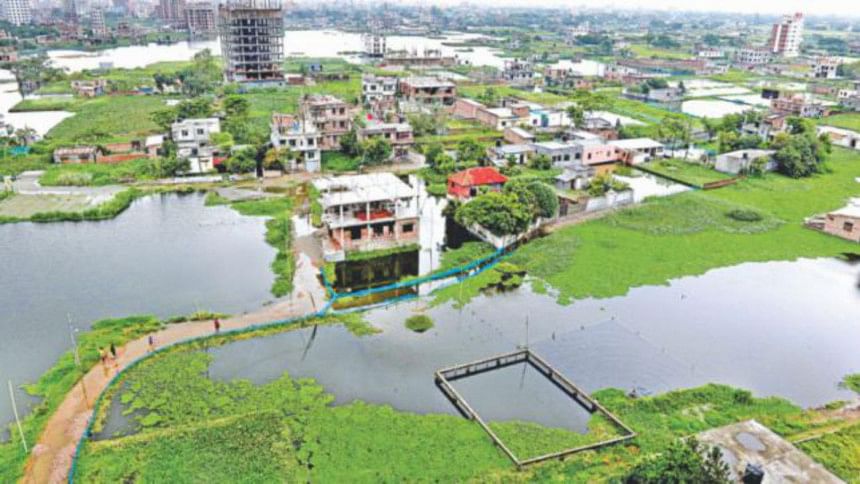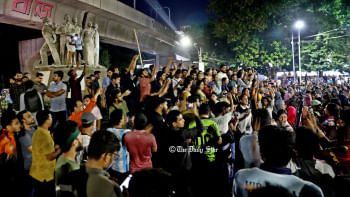Dhaka: Where will it go from here?

Dhaka, once the Venice of the East by virtue of being surrounded by four ebullient rivers, is now an urban behemoth. In our university days, going home on a long vacation, we would be literally pining for Dhaka after a couple of weeks of sojourn with parents. I remember having once entreated my parents, exuding warmth to an absentee son in their midst, "Now that I have seen you, and my heart is filled and refreshed, might I return to Dhaka earlier than scheduled?"
Why did we gravitate towards Dhaka then? The krishnachura-clad and tall rain tree-paved campus? Yes, that pristine charm was there but elementally Dhaka's water was among the best in the province and its unpolluted air brightened the skin. And it was a friendly city on top of everything.
But all that is history now. Even Uttara, supposed to be a model town, is a chaotic jungle of concrete where commercial buildings and residential high-rise apartments are an optical pain, let alone vitiating the atmosphere. And all this is devoid of a stipulated number of parks; and no patches of green breathing fresh air into the alleys.
The ledges, shoulder belts and sideways to the streets have been so broadened and encroached upon that the main thoroughfares have narrowed down, not to be serviceable as before. All this has happened in prime areas like Gulshan and Uttara!
Now talks are going on to develop East Dhaka like Pudong, or East Shanghai, which in 26 years has transformed from marshy outback into the "New York of China"—a vibrant financial and business hub of Shanghai. Similarities are being drawn between the Pudong of the old and present-day East Dhaka.
Qimiao Fan, country director of the World Bank for Bangladesh, Nepal and Bhutan says, "Go East". The parallels are striking: "To cross between East and West in Shanghai, one had to put a bicycle on the ferry." Fan is graphic when he says, "I would rather have a bed in West Shanghai than a house in East Shanghai."
In the case of Dhaka, the East is just six kilometres away from the western part; two parallel roads need to be bisected for connectivity. East Dhaka comprising 166 unions has an area comparable to that of some large European cities.
The Word Bank's country director who beckons us to follow Shanghai's example adds that at the international conference on development options for Dhaka, they presented a discussion paper, an invitational one, to debate and come out with solutions tailor-made to our conditions. It will require careful planning, proper implementation and close coordination, the generalised prerequisites, so to speak. We may have to take a cue from the urban journeys of New Delhi and Shanghai. But we think, nearer home is Kolkata's remarkable bounce back from a "decadent" city to a mellowing, aesthetic and free-flowing mega urban habitat!
To rivet on to the old world charm, this has, in fact, been retained in Bund, the old part of Shanghai. There you see the cobblestone roads, delectable gardens, seating arrangements topped up with privacy and tranquility, tucked away restaurants amid green pastures.
Even in London cobblestone roads and lake-laced and wooded retreats have been conserved and maintained as spruced up recreational spots.
There is no mistaking the fact, however, that the success of the Pudong project rested on central command (political will), single-minded pursuit, strict unified municipalities and an irrevocable timeline. We have to muster those strengths before we embark on such a mega project. Besides, digitalisation of land administration is imperative for fail-safe land acquisition and use.
Do we only pontificate and quarrel over upsides and downsides of a strategic plan with a "touch of novelty" to modernise Dhaka, trying to halt its progress even to the drawing board? Or do we give it a fair consideration based on the fact that acceptability of an idea lies in its merit and has little to do with the person who pronounces it or the institution he represents?
In the present case, Qimiao Fan, Yue Li and Martin Rama, country director for Bangladesh, Bhutan and Nepal, chief economist for South Asia region, and senior economist, respectively, of the World Bank have, out of a sense of urgency, followed up on a WB report on Dhaka's urbanisation challenge. They underscored an idea clothed in the novelty of an analogy between what is now the potential for Dhaka to grow in a balanced way and that which is already a reality for Shanghai.
It is common knowledge that the western part of Dhaka has no room for horizontal expansion so that a "look East" development policy may have been under consideration, if not on the anvil. With the big, concerning difference that the harmful pattern of development through land-grabbing, hauling up of sand from canals and choking of the water bodies that had inexorably degraded the environment in the West is going to be replicated on the eastern side, if left unguarded. The time is now to apply the brakes on no-holds-barred construction activities; lest they cross the critical threshold where prohibitive retrofitting costs would be entailed.
The World Bank experts' catchphrase is: unlock the potential of East Dhaka to ease the intense pressure off West Dhaka making Dhaka great just as a well-developed Pudong has propelled the greatness of Shanghai.
Forty-seven years since national independence, Dhaka's development plans galore has been stuck with the drawing boards or amended umpteenth time to suit influential quarters beyond redemption. How long shall we walk around with blueprints under our arms?
Shah Husain Imam is adjunct faculty in East West University, a commentator on current affairs and former Associate Editor, The Daily Star.
Email: [email protected]

 For all latest news, follow The Daily Star's Google News channel.
For all latest news, follow The Daily Star's Google News channel. 



Comments